





Introduction
Note: This astrology uses the sideral zodiac. Please be sure to read the section entitled "Astrological Method," below.
Individuals used in this study come from a list in a Wikipedia category entitled “Bisexual Writers.” It includes the statement “This category may inappropriately label persons.”
I took the list, cross-referenced it with birth data available on Astrodatabank, and came up with seventeen more possibly bisexual individuals I could do astrology on. When Astrodatabank biographical material did not show the individual as bisexual, I tried Wikepedia to see what was written there. Quotes are used from both sources.
So, this paper is a seventeen-examples addendum to an original paper, which, among other things, explored the astrology of bisexuality. Those interested in the full exploration of the astrology of sexuality, should consult the original paper at Original Paper on Bisexuality.
A more complete exposure to how this astrology demonstrates various forms of sexuality can be had by reading the two papers preceding the one on bisexuality, to whit, ones on lesbianism and homosexuality. Links are above.
In addition, a couple of papers exist which separate the sexual orientation of one twin from the opposite orientation of the other twin. Here are their links: One Twin is Homosexual, His Sister is Not , Twins: One Sister is Heterosexual, One is Lesbian. The former helps in positively identifying the first part of the significator for homosexuality. The latter confirms that 5° is the maximum allowable orb in a planetary set which includes one light.
Discussion on the significators for the astrology of bisexuality, presented in the original paper, is repeated below.
Charts That Demonstrate Bisexuality
Most of the time the charts involved will be either the 5th (the harmonic enlargement of the 5th house of sexuality and children) or the 7th (the harmonic enlargement of the 7th house of significant others). Occasionally, as also occurred in earlier papers on homosexuality and lesbianism, we find sex-life significators in other charts than the 5th and 7th. When that happens, those other charts appear more the “center of gravity” (COG) of the individual’s existence” than do the 5th or 7th:
For instance, individuals, particularly homosexuals, who discover their same sex attraction as a pre- or early teen often have their sex-life indicators in their 1st chart of early childhood and its somatic ramifications. That chart appears to be the COG of their experience of themselves. Some one who “always knew” s/he was homosexual or lesbian can have their significators in their (1st or) 3rd charts (the harmonic enlargement of the 3rd house which shows our habitual, mundane thinking). It is not really surprising this chart can contain the significator for sexual preference because sex, thinking, and imagination are highly linked.
To illustrate further, examples of the 9th chart being the center of gravity of the individual are found throughout the papers on gurus and Catholic saints. Here are their links:Paper on Eastern Gurus, Paper on Catholic Saints. But the 9th house and 9th chart refer to more things than just religion, so we can find the 9th chart the COG chart of Yale professor of history and linguist, John E. Boswell, written about in the paper on homosexuality. Moreover, all gurus do not have their 9th chart as their COG. One example was Osho, whose COG chart was his 3rd because that is the chart that contained sets evidencing his spiritual attainments. The 3rd chart, with references to the 9th house in that chart, was the COG of the genius Nikola Tesla, who was not only a genius, but who apparently accessed laws and principles not so available to the rest of us..
Unfortunately, biographies that accompany astrological data do not usually include nearly enough information to discriminate in which chart an individual’s has his center of gravity. That being the case, and since our consciousness as sexual beings focuses primarily around our 5th and 7th charts, in all three studies I have started first by erecting the 7th chart (the major chart of this method), followed by the 5th. If neither chart contained the significator I was looking for, I then ventured into other charts. Almost always, when that was the case and when enough information was available about the individual, the chart that ended up being the COG one was reasonably the COG chart. But, if we know only that an individual is a lesbian (or was at the time she gave her birth data), no chart other than the “reasonable” 5th and 7th chart is suggested. Only further work with in this area, accompanied by for more biographical material, can determine if the COG chart holds up as a realistic concept.
Until then, a weakness of my approach is that even if the 5th or 7th chart contain the significator I am looking for, neither may be the COG chart. My assumption is that it is always better to work first with that chart.
Again, sexual significators usually fall in the 5th or 7th charts, but because humans are capable of diverse forms of identification, any one of the twelve charts may validly contain those significators if the chart represents the center of gravity of that individual’s consciousness.
The Significators—Planets and Paths—Found So Far For Bisexuality
The significator for bisexuality occurs as mercury conjunct the Descendant, or mercury ruling a 5th, 7th or 8th house and made Angular by any one of the four Angles of the chart. The acceptable orb of mercury-to-Angle is 4°, rather than the standard 2° for planet/Angle. These charts are un-rectified and we need to allow a slightly larger orb in order to catch possible significators which would otherwise be lost.
Stated slightly differently, the significator for bisexuality shows as one of the several conditions listed below:
So, in all the sets described above, the mercury must be Angular. And the orb for mercury-to-Angle is a maximum of 4° (extended about one degree when a light—sun, moon, or node—is also on the Angle)
The significator for bisexuality occurs as a second part of a sexual significator in charts which can be heterosexual, homosexual, or lesbian. That is, any bisexual individual may have the primary significators for homosexuality, heterosexuality, or lesbianism (see those papers for definition). But, if the chart contains the significator for bisexuality, then the individual is bisexual, or at least has the option of bisexuality. Even when a chart looks homosexual because it contains both first and second parts of homosexual significators (see paper for definitions), when it also contains the significator for bisexuality, the individual is bisexual. He/she may later decide to choose to focus on same sex attractions, but they start out bisexual, and can always revert to it.
The astrology of bisexuality demonstrates that bisexuality can also occur in the absence of the significators for homosexuality (for males), and in the absence of the significators for lesbianism (for females). When it occurs as an astrological option, bisexuality dominates all other categories of sexuality, their presence or absence in charts.
To see the wide range of influence of second parts of signficators, read the paper on Bruce Lee's life and death. It illustrates another important Angle/planet modifier. It affects physical existence and is found in the 1st chart as a significator that works against the one for allergies: Paper on Bruce Lee.
Having stated the above, it should be mentioned that an individual may choose not to exercise his/her bisexual option in favor of sticking to norms for his/her sex. Such refusals can take place for a number of reasons. Here are some I know about:
Returning to discussion of mercury as the planetary significator for bisexuality, the original paper on bisexuality includes a quote from a discussion of the historical meanings of mercury under the title Mercurius – Hermes. A search for that title in that paper (Paper on Bisexuality ) brings up that discussion.
It basically boils down to the fact that mercury is dual—suggested by the fact that one of the signs it rules, Gemini, is a sign represented by twins. But it is not just dual, it appears to contain opposites within itself, like Yin and Yang. I write “opposites, but male and female are not really “opposites. “ They are on the extreme ends of a continuum called sexuality, and change into each other. But, even with mercury only representing rationality in regard to sexual preference, it puts mind rather than blind biology on the throne. Mind says, then, “you have a choice.”
Mercury has other applications in the 5th house, or in the 5th or 7th chart. In the section below discussing the astrology of the author Thomas Mann, I have put a short discussion of mercury as it appears in the 5th and 7th chart for the birth or death of children. And, also, something about mercury/Gemini, different from the significator for bisexuality, as it sometimes translates as pederasty, with a link to the paper that contains the chart of Richard Allen Davis, pederast. There is much more to be learned about the latter significator.
Before starting with examples from charts, we need to know something about this form of astrology. The information below concerns this particular astrological method.
Astrological Method
This method is not traditional. It uses a birth and conception planets and their harmonics and houses, all of which share the same axis. :
This astrology uses the sidereal positions of the planets based on the Fagan-Bradley’s SVP.
Harmonics are taken from the sidereal position of the planets. The Egyptian harmonic, discussed in the paper “About This Method” (link below), is used.
”Lights” include suns, moons, and moons nodes. When mercury rules one or two Angles, it also acts like a light and has the same orb as the other lights. The MC or Asc also acts like a light, but one with only a 2° orb, because when a set is on an Angle it does not need a light to be active.
This method uses only conjunctions, applying and separating squares, and oppositions. (There is a table in the paper on chartrules which shows which traditional aspects--e.g., semi-square, trine, quincunx, etc.--in the sidereal are converted to conjunctions, squares, and oppositions in the harmonics and which charts they occur in, link below.) Orbs for static planets with lights is 5°; without lights, about 2.5°. Orb for MC/planet or Asc/planet is 2°. Planets so related to each other are referred to as in the same “set.” A set, then, is two or more planets (or an Angle) connected to each other through conjunction, square, and opposition within the defined orbs. Sets without Angles are more active when they contain a light, and less active without one. Learning to look in terms of “crosses” can be helpful in rapidly finding planets that are in the same set.
Because this approach uses both a birth and conception chart and they share the same axis, birth houses usually overlap different houses of the conception chart. These are called “house overlaps.” As it turned out in this paper, house overlaps were not significant. They can be for some other conditions. Throughout this paper I use the convention when writing about house overlaps of putting the birth house first, then the conception house. So, for instance, a “5th/1st” overlap refers to an overlap of birth 5th house with conception 1st house in that order.
Birth planets (including their harmonics) rule only birth houses. Conception planets (including their harmonics) rule only conception houses.
For a more thorough explanation of this astrological approach, refer to the following papers:
About This Method
Chart Reading Rules
In the partial charts shown below, birth planets and their harmonics are inside the circle. Conception planets and their harmonics are outside the circle. Conception sidereal planets are red; conception harmonic ones, black. Birth sidereal planets are blue; birth harmonic ones, green. Occasionally, because of space limitations, I have had to violate this inside/outside arrangement, but the color coding remain constant.
Abbreviations used are b = birth, c = conception, and t = transiting. Even though the harmonic used for each chart is always two more than the chart’s number, in these papers—for ease of reading—I write the harmonic number the same as the chart number. For example, the 5th chart uses the 7th harmonic, but I have established the convention of writing harmonic planets for the 5th chart as, e.g., c5 mars, which reads, “the harmonic for the 5th chart for conception mars.”
Throughout this paper sets are numbered sequentially, rather than beginning at 1 again for each new individual. So the sets run from 1 to XX. By assigning unique numbers to each set, reference to any one set becomes a simple matter.
For each partial chart below, house cusps for 11th, 12th, 2nd, and 3rd houses are are shown below the drawing. Birth ones are blue. Conception house cusps, red.
Now we can start looking at charts. They are fairly simple, for the most part showing only the significator for bisexuality and nothing else.
Seventeen Charts of Bisexual Men and Women
Most of the charts in this section are of confirmed bisexuals. I have highlighted (italics or bold) suggestions in their biographical material that they were bisexual.
Died 12/24/1982, Paris.
That doesn’t tell us of any reputation for being bisexual, but some was found in the Wikipedia biography (1/17/11):After the death of his wife on June 16, 1970, Aragon came out as bisexual, appearing at gay pride parades in a pink convertible. Drieu La Rochelle had evoked Aragon's homosexuality in Gilles, written in the 1930s.
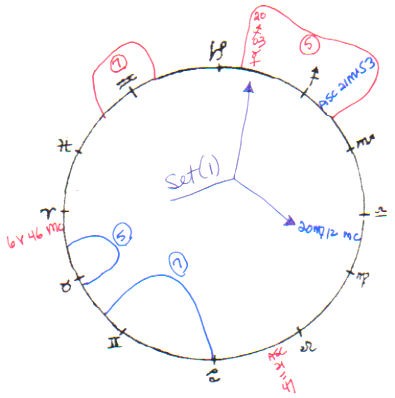
Set (1) contains c mercury in c 5th house made Angular by B MC. It is his bisexual significator.
Part of Aragon’s “prodigious” literary output was sponsored by his conception moon, which was at 26 Gemini 32 and ruled C Asc in Cancer.

Heir to the Burroughs Adding Machine Company fortune, William was raised in upper middle-class circumstances in St. Louis, Missouri. He was a bookworm fascinated with guns and crime, showing an innate inclination to break all the rules. His parents seemed to accept the fact that he would never fit into normal society, and after he graduated from Harvard in 1936, they continued to support him financially. Aware of his strong homoerotic drive, he experimented with various lifestyles.
Searching for identity, Burroughs moved to New York when he was in his early 30’s, where he joined the city’s gangster underworld. Buying stolen goods and drugs, he intentionally became a heroin addict in the early ’40s after initially experimenting with morphine. In 1943, he met Jack Kerouac and Allen Ginsberg, two writers who later became principal figures in the "Beat" movement. The three became close friends, and Kerouac once described Burroughs as "tall, 6' 1", strange, inscrutable because ordinary looking, like a shy bank clerk with a patrician thin-lipped cold blue-lipped face." They were impressed by his obvious intelligence and worldly cynicism, and were interested in his underworld experimentation.
A strong emphasis on personal freedom is evident in his life and his writing, and he moved to East Texas, joined by Herbert Huncke and Joan Vollmer Adams, where he became a farmer, growing oranges, cotton and marijuana. The threesome lived in squalor on the farm, addled by the drugs they took. Burroughs’ life during that period was later used as fodder for Kerouac’s book "On the Road."
By his mid-30s, Burroughs had not published anything although he was surrounded by others who had established their writing careers. Apparently indifferent to serious literary thought, he wrote "Junkie: Confessions of an Unredeemed Drug Addict," an autobiography about his heroin addiction, which was published under the pen name, William Lee. Ginsberg arranged for its release as a pulp paperback by Ace Books. Burroughs’ next attempt, "Queer," was a study of his homosexuality, but it was not published for many years. He went on to write many books, film scripts, plays and essays, and modern rock musicians often cite the crystalline clarity and raw power of his writing as their inspiration. In the early 1950s, he traveled to South America in search of a drug called yage, and his letters from that period were later collected and published as "The Yage Letters," 1963. In 1981, he settled in Lawrence, Kansas.
In 1947, he began to live with Joan Vollmer, who became his second wife; they had one son together, William S. Burroughs, Jr. In the early 1950s, with the authorities after him for his drug activities, they moved to Mexico, taking Joan’s son from her first marriage with them. It was there that he accidentally shot and killed her in a drunken prank on 9/06/1951, while trying to show off his marksmanship abilities by shooting a glass off her head. He was arrested, but later released on bail. After Joan’s death, their son lived with Burroughs’ parents in Florida…
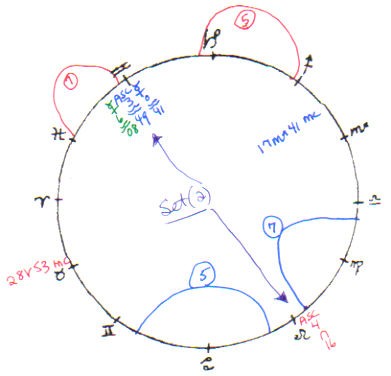
Set (2) shows b mercury and its harmonic conjunct B Asc and on C Desc. Those mercuries also rule b 5th house and co-rule (20 of 47°) b 7th house.

Cassady grew up during the poverty of the Depression. When he was six his parents separated and he moved to a condemned building with his dad, a meek, guilt-ridden alcoholic. He was a hard worker as a brakeman for the railroad for ten years, a laborer at the Los Gatos Tire Company, and an auto mechanic. His unfinished autobiography was published posthumously as "The First Third."
His education was primarily in reform school, stealing the first of some 500 cars at 14, getting off on the rush of danger. He had a gift of gab and bi-sexual electricity. After getting out of jail he married a 15-year-old runaway, LuAnne, briefly before he met and married Caroline Casey with whom he had three kids and spent most of his adult life.
After a friend introduced him to Jack Kerouac, they became close pals and he was accepted into Kerouac's intellectual campus crowd as a colorful addition. He was married to Caroline when Jack Kerouac moved into the attic in 1952; the three became a ménage a trois. He was the model for Kerouac's later character "Dean Moriarty" in his "On the Road," published September 1957.
Cassady spent two years in prison for giving a cop a joint in 1958. He spent the next decade as a rootless wanderer, turning up in the '60s as one of Ken Kesey's Merry Pranksters and the driver of the famed psychedelic bus.
He died at 42 of pneumonia from exposure in San Miguel de Allende, Mexico 2/04/1968, his body found beside the railroad tracks.
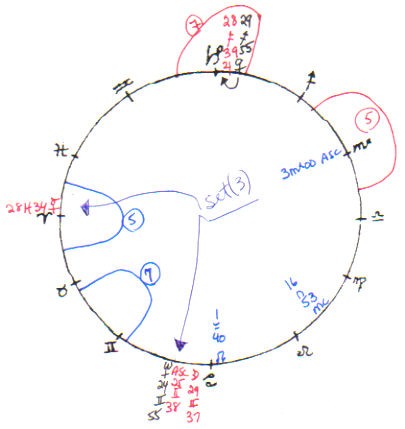
Set (3) shows c mercury in b 5th house made Angular by C Asc in Gemini. C mercury also rules C Asc in b 8th house.
Note there are two lights in the set—c moon in Gemini and c mercury (because when mercury rules an Angle it acts like a light). The two lights make his conjunction of venus and jupiter in Sagittarius Angular, too. They demonstrate his “bisexual electricity” (Angular golden benefic).
Ram Dass was born Richard Alpert into a wealthy family. His father, George Alpert, was a Boston attorney who helped found Brandeis University, then took control of the New Haven Railroad in 1956. Though encouraged by his father to seek a medical career, Ram Dass collected degrees from Tufts, Wesleyan and Stanford, then became a psychology professor at Harvard. Immersed in sports cars, antiques and even an air plane, Ram Dass pursued the "middle-class bachelor" life until the early '60s, when hallucinogens changed his world view.
With his friend, Timothy Leary, he allowed undergraduates to participate in drug experiments, for which both he and Leary were fired from Harvard in 1963. The pair moved to Mexico to open up a "psychedelic training center," and were expelled from Mexico also, eventually settling into a 63-room mansion in Millbrook, N Y, owned by heirs to the Mellon fortune.
Ram Dass soon tired of Leary's confrontational style with authority, and the pair split though remaining friends. Ram Dass traveled to India where he met a guru who changed his life and eventually, his name. Ram Dass means "servant of God" in Hindi. Dass began to see hallucinogens as shallow and artificial. He became a Guru himself, a leader to those on the spiritual quest.He reportedly struggled with relationship issues, including sex, alternating between celibacy and bisexuality.
When his dad fell ill, Ram Dass became his personal caretaker. During the '80s he urged people to engage in selfless service as he himself was working with the homeless, setting up a hospice for dying people and helping to start the Seva Foundation to treat the blind in third-world countries. In the late '80s, he became an activist for the Seva Foundation, a Michigan-based charitable group he co-founded. Seva has helped fund reforestation projects in Latin America and health education for Native Americans in South Dakota. Its principal goal is to fight blindness in India and Nepal and it has funded cataract operations as well as training for local doctors. Ram Dass raised $500,000 during a 60-city lecture tour.
He resides in the San Francisco Bay area. On 2/19/1997 he had a stoke, leaving his left side partly paralyzed. His book, "Still Here" was published that year. It was ironic that a master at speaking, a brilliant teacher and hilarious raconteur who could hold thousands rapt now could not speak, that he had been silenced by illness. A week later, Ram Dass began his recovery, and he embarked on a long course of rehabilitation. He said the stroke had taught him to appreciate silence. He suffers continual pain, particularly in his right arm, and also has high blood pressure, gout and apnea, which requires him to sleep hooked up to a respiratory machine so that he won't stop breathing. After the stroke, his friends said "He became much sweeter and softer."
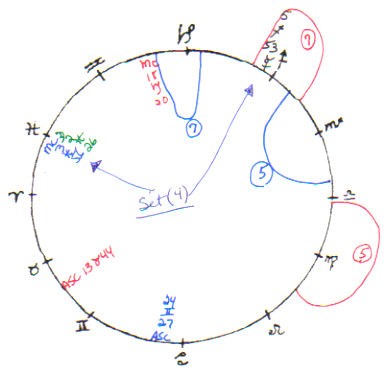
Set (4) shows c7 mercury in c 7th house made Angular by B MC in Pisces. C7 mercury also co-rules (28 of 31°) c 5th house.
Beauvoir was the eldest daughter of a middle-class lawyer, raised Catholic with a convent education. She sided with her dad as an atheist at 15. While at the Sorbonne, she gained the nickname "Beaver" for being industrious, a name by which she was known for the rest of her life.
In 1947 she made a trip to New York for a lecture tour where she met Nelson Algren, author of "The Man With the Golden Arm." They began a passionate affair that continued intermittently for some 15 years. When they finally parted, it was with some bitterness, however, in her last letter to him in 1963, she wrote that she would love him forever.
She obtained math and philosophy degrees from the Sorbonne when she was 21, and taught there from 1931-1943, when she wrote her first novel. She regarded herself more as a Marxist than a feminist. With a stern, though unconventional morality, she devoted her full time to grappling with the taboos of her time in her writing. Her work, "The Second Sex," 1949, was hailed as a landmark examination of the position of women in a male-dominated word and sold over a million copies in paperback in the U.S. alone. In 1954, she won the Prix Goncourt, France's most coveted literary award, for her novel "The Mandarine." Her books include "The Prime of Life," 1962 and "Force of Circumstances," 1965.
As can be seen, Astrodatabank makes no mention of bisexuality. Neither does Wikipedia. The only allusion to her possible bisexuality occurs in a citation in the Wikipedia article: “Frauer, M. 1999. “Identity Without Selfhood: Simone de Beauvoir and Bisexuality.” Cambridge and New York, Cambridge University Press.” I have not seen this book, and have no idea if it confirms that she was bisexual. All we can do now is look at her chart.
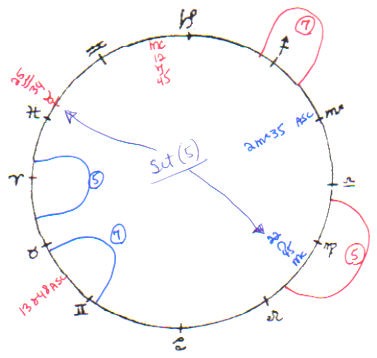
Set (5) is comprised of B MC in the same set with b7 venus in Scorpio and c mercury in Aquarius. B7 venus rules b 7th house. C mercury co-rules (20 0f 41°) c 5th house. Her chart, at least, says she was bisexual.
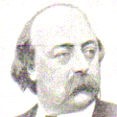
The son of a prominent doctor in Rouen, Flaubert was sent to Paris to study law between 1840 and 1843. He had an illness which left him incapacitated, presumably a type of epilepsy. His protective mother spent her entire life catering to his every whim, anticipating his financial needs before he even expressed them. Flaubert was fond of the financial and physical security of his family home and eventually returned there to spend the rest of his life writing. Daily life in his mother's house was conducted in hushed whispers until he awoke close to noon. Mme. Flaubert then rushed to his bedside for a long chat, after which he arose, ate a huge lunch and spent the afternoon getting ready to work on his writing until far into the night.
Flaubert spent a lifetime torn between the crude appetites of the flesh and the seraphic aspirations of the soul, between the gutter and the radiant heavens, between the reality and the dream. He attended prostitutes and mistresses to satisfy his carnal desires, most notably poet Louise Colet, a twice-awarded winner of the prestigious poetry prize by the Academie Francaise. They met in 1846 and she published her account of their relationship in "Lui," 1859. When he could no longer resist the pleas of his mistress, he would go to Paris for several weeks of hyper sexuality until he felt the need to return to "Poor old darling," which he called his mother.
After the death of both his parents he moved to the family's country home near Rouen. Flaubert's relationship with Collet ended in 1855. From November 1849 to April 1851 he traveled with the writer Maxime du Camp in North Africa, Syria, Turkey, Greece, and Italy. On his return Flaubert started to work on Madame Bovary, which appeared first in the Revue, 1856 and in book form the year after. The realistic depiction of adultery was condemned as immoral : Flaubert was prosecuted, though he escaped conviction, which was not a common result during the official censorship of the Second Empire.
In the 1860s Flaubert enjoyed success as a writer and as an intellectual at the court of Napoleon III. Among Flaubert's later major works are "Salammbô," 1862, and "The Temptation of Saint Antony," 1874.
On 5/8/1880 he died in Croisset, France. Rumours circulated that he had somehow strangled himself in the bathtub, however, it is more probable that he had just stepped out of the bathtub when he suffered a stroke.
The above material doesn’t mention anything about bisexuality, but we have something from Wikipedia (1/17/11):Flaubert was very open about his sexual activities with prostitutes of both sexes in his writings on his travels. He suspected that a chancre on his penis was from a Maronite or a Turkish girl. He also engaged in intercourse with male prostitutes in Beirut and Egypt; in one of his letters, he describes a "pockmarked young rascal wearing a white turban" with whom he had anal sex. He had intercourse with a 14-year-old Maronite boy in 1850. He also attempted to have intercourse with a 16-year-old girl at a brothel, but when the girl demanded to see his penis to check for venereal diseases, he marched out in false indignation that she would accuse him of such a thing—he was hiding an induration on his penis and was afraid she would see it.
Since I did not find a bisexual significator in Flaubert’s charts, I am not presenting his chart.. Of all twelve of his charts, he had two which had Angular mercuries. But neither of them had an connection to 5th, 7th or 8th houses.

Andre Paul Guillaume Gide was raised in a family dominated by women as his father had died when he was 11. He attended various French schools, and published his first work in 1891, "Les Cahiers d’Andre Walter" ("The Notebooks of Andre Walter"), and a number of other works thereafter at his own expense. When "Fruits of the Earth" appeared in 1897, it was the most extreme example of Gide’s attraction to poetic prose, and was a breakthrough for Gide in its celebration of the senses.
Gide's preoccupation with individual moral responsibilities led him to seek public office. After filling municipal positions in Normandy, he became a special envoy of the colonial ministry, 1925-1926 and wrote two books describing conditions in the French African colonies. These books, released in 1927, were instrumental in bringing about reforms in the French colony law. His work continued in novels, plays, critical studies and poetry.
Between 1933 and 1936, Gide made antifascist speeches and wrote articles, and presided at various leftist meetings. In 1936, however, a disillusioning trip to Soviet Russia changed his outlook.
His mother died on 10/8/1895, and two weeks later, after inheriting a considerable fortune, he married his cousin, Madeleine Rondeaux and soon returned to Algiers. It was said to have been an unconsummated marriage. When Madeleine discovered his predilection for homosexuality, she fled to the estate in Cuverville and Gide began his extensive travels. She died in 1938, unaware that in 1923, Gide had fathered a daughter, Catherine, more or less as a favor to the child’s mother, Elisabeth van Rysselberghe.
Gide died in Paris on 2/19/1951. "I love life passionately," he wrote, "But I don't trust it."
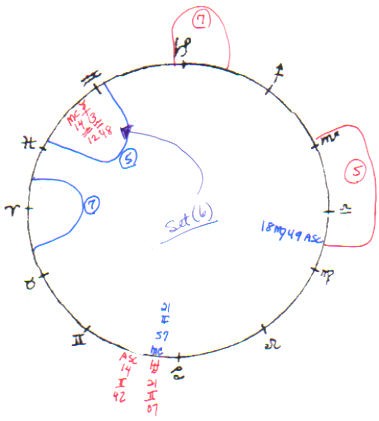
Set (6) shows c mercury in Aquarius conjunct C MC in b 5th house. C mercury also rules C Asc and c 5th house.
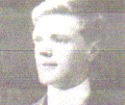
"Bertie" was the fourth child of an abusive coal miner and a refined mother whom he idolized. After surviving bronchitis at the age of two weeks which left him in permanently delicate health, he grew to be a frail and hyper-sensitive child who was often in tears and was overly dominated by his unhappy mother Lydia. His parents' marriage was disastrous. Lydia, a refined schoolteacher, met Lawrence's father, Arthur, at a local dance, where she fell in love with him. After the wedding, she found that Arthur did not own his own house and did not work in the mining office, as she had been led to believe, but instead labored as a miner himself. Her profound disillusion and subsequent misery is reflected in Lawrence's persistent theme in his novels of the elegant, well-bred woman under the influence of a common, low-bred man. As a child, Lawrence dazzled his family with his ability to copy paintings of the masters, and lioness Lydia demanded that her intelligent, talented and fragile son escape the drudgery of a miner's life and seek higher education.
After graduating a two-year teacher's training course at University College at Nottingham, Lawrence accepted a teaching job in the London suburb of Croydon. Taking up writing at the age of 19, he had four poems published in "The English Review" in 1909, which launched his writing career. Ford Madox, editor of the "The English Review," mentored Lawrence as a budding writer and was influential in publishing his first novel "The White Peacock," three years later. The moderate success of the book was overshadowed by the death of his beloved mother the same year, plunging Lawrence into a depression which resulted in a near-fatal attack of pneumonia from which he never fully recovered.
In March 1912, with two more novels in progress, he accepted a luncheon invitation from Professor Weekly, his favorite teacher from Nottingham and met his aristocratic wife Frieda. According to legend, she had Lawrence in her bed within 20 minutes after meeting him. Two months later they eloped to Germany, marrying in 1914 when Frieda's divorce became final. When they returned to England at the outbreak of WW I, they were forbidden to travel outside of it, as Lawrence's outspoken opposition to the war and Frieda's German birth aroused the suspicion that they were spies. They left England in 1919, returning only for short visits thereafter.
The couple led a peripatetic life through France, Italy , Sri Lanka, Australia, California and Mexico, where Lawrence was diagnosed with tuberculosis in 1925. Seeking a suitable climate for his increasingly poor health, they rented a home in Taos, New Mexico and finally to the French Riviera in 1927 where, after medical treatment, it was concurred that his condition was grave. Despite his illness, Lawrence wrote voraciously during these years, introducing Freudian theory into the modern novel and especially writing openly about sexual passion and its necessary and explicit incorporation into human expression. His theory of "blood consciousness" was a constant emphasis on humanity basing its decisions on instinct rather reason. When his best known work "Lady Chatterley's Lover" was published in 1928, it was banned in England and the U.S. for describing the sexual act in minute detail. Thirty two years later the United States Supreme Court overruled the censorship and it was published again that same year.
Lawrence's marriage to Frieda was just as disastrous as the marriage between his parents. With mother-son love serving as the lens through which Lawrence perceived artistic vision, Frieda took the brunt of his psychological maladjustment through verbal and often public physical abuse. She was forbidden by Lawrence to even mention the names of the three children she left behind in her marriage to Weekly. In later years he felt that women's sexuality sapped all his spiritual strength and envisioned an ideal sexuality as homosexual, which he did not himself practice.
Consumed by tuberculosis, he died in a sanitarium in Venice, Italy with Frieda at his side on 3/02/1930. After his death Frieda wrote "In his heart of hearts, I think he always dreaded women, felt that they were in the end more powerful than men."
Wikipedia has this to say: While writing Women in Love in Cornwall during 1916–17, Lawrence developed a strong and possibly romantic relationship with a Cornish farmer named William Henry Hocking. Although it is not absolutely clear if their relationship was sexual, Lawrence's wife, Fieda Weekley, said she believed it was. Lawrence's fascination with themes of homosexuality could also be related to his own sexual orientation. This theme is also overtly manifested in Women in Love. Indeed, in a letter written during 1913, he writes, "I should like to know why nearly every man that approaches greatness tends to homosexuality, whether he admits it or not…" He is also quoted as saying, "I believe the nearest I've come to perfect love was with a young coal-miner when I was about 16."
His chart show the bisexual option.
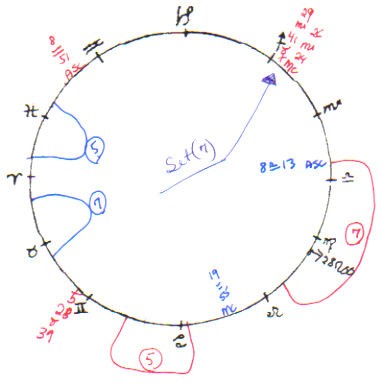
Set (7) shows c mercury conjunct C MC. C mercury rules c 5th house and co-rules (30 of 60°) c 7th house.
I put in the mars and saturn which were also part of the set. Because they are both malefics, they likely have a negative effect on his bisexual option. Mercury/mars/saturn in 5th or 7th charts is hard (mars/saturn) for children (mercury), either preventing them, or taking them away some time after birth. Much depends on other indicators for children in the chart. Lawrence did not have children. We do not know whether or not Frieda ever conceived any with him.

Thomas grew up in a wealthy merchant family in Lubeck, Germany. His father was a grain merchant and city senator. His mother was a pianist and a planter's daughter from German-Brazilian parentage. As a boy, he loved to day dream and visit the sea. He hated school and failed twice. In 1891, his dad died and the family grain business was liquidated. At 16, his mom moved the family to Munich. It was that year when Thomas began to write his first collection of short stories.
As an army draftee, he contracted tendentious after a few drill parades and soon discovered the army was not a place for him. In 1901, his work "Buddenbrooks" was published. making him a popular author in Germany. With the excellent notices from his novel at the age of 26, Mann settled into writing career. During WW I, he wrote his manifesto on German patriotism, "Meditations of a Nonpolitical." In 1924, his book, "Magic Mountain" was published. His works included "Joseph In Egypt," 1938 and "Doctor Faustus" in 1947. His experience with WW I gave way to a stand on principle against Nazism during the rise of Hitler in the 1930s. In February 1933, Mann gave a speech about Wagner which upset Hitler and the Nazi Party. He continued a lecture tour of the Netherlands but found German newspapers highly critical of his political views. In October 1933, Mann made his home in Zurich, Switzerland, finding himself no longer welcome in Germany. He eventually settled in Los Angeles, when he was 70.
In 1905, Mann married Katia Pringsheim, the Jewish daughter of a mathematician, a family whose members were among the German Jewish elite. In 1907, Mann called himself a philo-Semite. His school friends, publishers, and people he preferred to keep company with were from the Jewish heritage. Mann was far from an orthodox Aryan, believing German Jews appreciated excellent writing and artistic pursuits. After two years of marriage, Mann began to resent being tied down to a wife and child. Mann and his wife eventually produced six children. They vacationed at exclusive spas and were attended by servants where ever they traveled. As a writer, Mann hated discipline.
Mann died of phlebitis on 8/12/1955 in Zurich, Switzerland.
The above states nothing about bisexuality. We have this from Wikipedia (1/19/11): Mann's diaries, unsealed in 1975, tell of his struggles with his homosexuality which found reflection in his works, most prominently through the obsession of the elderly Aschenbach for the 14-year-old Polish boy Tadzio in the novella Death in Venince (Der Tod in Venedig, 1912). Anthony Heilbut’s 's biography Thomas Mann: Eros and Literature (1997) was widely acclaimed for uncovering the centrality of Mann's sexuality to his oeuvre. Gilbert Adair’s work The Real Tadzio (2001) describes how, in the summer of 1911, Mann had been staying at the Grand Hotel des Bains on the Lido of Venice with his wife and brother when he became enraptured by the angelic figure of Wladyslaw Moes, an 11-year-old Polish boy (see also "The Real Tadzio" on the Death in Venice page).
Handling the struggle between the Dionysiac and the Apollonian, Death in Venice has been made into a film and an opera. Blamed sarcastically by Mann’s old enemy, Alfred Kerr, to have ‘made pederasty acceptable to the cultivated middle classes’, it has been pivotal to introducing the discourse of same-sex desire to the common culture. Mann was friends with violinist and painter Paul Ehrenber for whom he had feelings as a young man. Despite certain homosexual overtones in his writing, Mann fell in love with Katia Mann—whom he married—in 1905. His works also present other sexual themes, such as incest in The Blood of the Walsungs (Wälsungenblut) and The Holy Sinner (Der Erwählte).
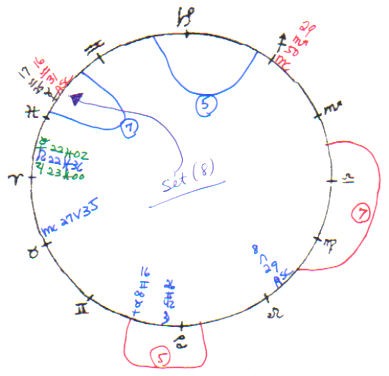
Set (8) shows c5 mercury conjunct C Asc in b 7th house. C7 mercury also rules c 5th house and co-rules (30 of 58°) c 7th house.
The two planets in Gemini in c 5th house suggest attractions to young people, such as occurs with pedophiles. In his 7th chart that moon in Gemini is conjunct b7 mercury at 24 Gemini 03. Gemini/5th is prominent in the several charts of pedophiles I have examined (there is not more data available than that on pedophiles), but one has to be careful because such astrology can simply indicate an interest—but not sexual interest—in children. Likely other parts of the chart—especially whatever shows truncated sexuality or sexual immaturity—help push the interest in children to a sexual one. An example chart is included in the paper about the abductor and murderer of Polly Klaas, Richard Allen Davis. Here is the link: Paper on Polly Klaas
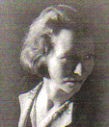
Millay died on 10/19/1950, Austerlitz, NY.
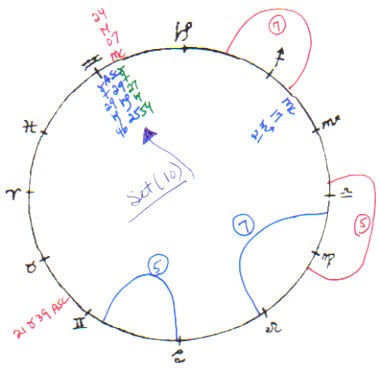
Set (10) shows birth mercury and its harmonic, rules of b 5th house and co-rulers (20 of 51°) b 7th house, conjunct B Asc, meeting the requirements for the bisexual significator.
I should point out that ruler of a 5th house in a 1st also indicates an early (1st house) introduction to sexuality (5th house). For that reason, it is almost always found in the charts of sexually abused children (not murdered ones). There are other ways such consciousness can occur without it being sexual abuse. It might be an usually early consciousness of human sexuality. Only more research, with thorough biographies, can identify all the possibilities.
The significator for poetry is Angle/light/mercury/venus/3rd. The mercury/venus promotes beautiful (venus) speech, the 3rd influence means the ordinary mind is occupied with such activities, and the Angularity means it is forefront in the life, indicating the possibility of recognition as a poet (if the chart is benefic enough). Saturn is often part of the set, perhaps indicating a profound (saturn) concern with form (saturn), and perhaps indicating the emotional pain (venus/saturn) that is aided through disciplined (saturn) expression (mercury). There is often a light in Pisces, indicating sensitivity and the challenge to expression that can occur with Pisces or strong neptune.
The poet’s significator is usually found in the 7th, 10th, or 3rd chart. It was also not in her 1st or 12th charts. Hers occurred in her 9th chart, which therefore looks like her center of gravity chart. A hint occurs in the small amount of biographical material presented above, “she traveled around the world with her husband.” I have not read her other poetry, but “Renascence” is about death and rebirth, so perhaps that, too, is a hint that she is focused in her 9th chart.
Here is the set showing her 9th chart significator set for poetry. There are three lights in the set—2 suns and a node, plus B Asc which has a 2° orb:
| Set (10a) | b9 saturn | 28 Capricorn 20 | ruler of B Asc in c 10th house |
| B Asc | 29 Capricorn 25 | ||
| b mercury | 29 Capricorn 46 | ruler of b 5th, 6th, and 8th houses | |
| c mercury | 23 Aries 26 | co-ruler (30 of 42°) c 5th house | |
| c9 venus | 26 Aries 52 | ruler of C Asc | |
| b NN | 27 Aries 12 | ||
| c venus | 26 Aries 52 | ruler of C Asc | |
| c sun | 0 Taurus 06 | ruler of c 5th house | |
| c9 sun | 1 Taurus 05 | ruler of c 5th house | |
| b9 mercury | 27 Cancer 27 | ruler of b 5th and 8th houses | |
| b9 mars | 29 Cancer 44 | ruler of b 3rd house |
We only have the year she won the Pulitzer Prize for poetry. Under those circumstances, I use the approximate midpoint of the year to do progressions to see if they match the award. At that time Millay had progressed C MC to jupiter and progressed B Asc to venus—something we would expect for such an honor. Most telling was her third important progression for the time:
| Set (10b) | c mercury | 23 Aries 26 | |
| progressed b venus | 23 Aries 41 | co-ruler (17 of 23°) b 3rd house | |
| progressed c9 jupiter | 24 Aries 14 | ruler of c 8th house | |
| progressed b NN | 24 Aries 38 |
Note the above set includes NN/mercury/venus/3rd, and all of it occurs in b 3rd house. It has no Angle influence, but progressed node/planet sets are very powerful and appear not to need such influence to express powerfully. But she also had a progressed Angle/venus plus a progressed Angle/jupiter, so this chart was powerful benefic when she received the Pulitzer Prize.
Millett moved to Japan where she had her first one-woman show at the Mirami Gallery, 1961-1963. She operated on an international level between Tokyo and New York, designing furniture, painting and teaching English. Bi-sexual, she married sculptor Fumio Yoshimura in 1965.
She is the author of "Sexual Politics," 1970, which became the cornerstone of the modern feminist movement, followed by another novel in 1974 and her autobiography in 1977.

Set (11) shows c7 mercury conjunct birth Descendant.
Rich married 6/26/1953, had three sons and was widowed 10/20/1970.
According to Wikipedia (1-17-11), Rich came out as a lesbian in 1976, five to six years after her husband’s death.
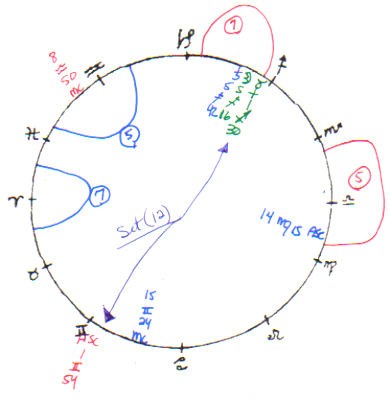
Set (12) shows b7 mercury conjunct conception Descendant. B7 mercury also rules B MC and B Asc in c 5th house
His father deserted the family in 1860, leaving the boy with a very severe mother; Rimbaud made numerous attempts at running away. A teacher, Georges Izambard, influenced him to begin writing, his first published verse at 15. When he was 17, he composed the poem, "The Drunken Boat," which he submitted to Paul Verlaine. Verlaine was so impressed with the young man's abilities that he implored him to move to Paris. They began a strong, stormy relationship, with Verlaine attempting to kill Rimbaud twice, the latter of the two injuries very serious. His writing, "A Season in Hell," was written in 1873, the year that he was shot by Paul Verlaine in a lover's quarrel, giving an allegorical accounting of the matter.
In 1880, Rimbaud moved to North Africa to become a trader, explorer, gunrunner and possibly slave trader. While he was in Africa, Verlaine assumed that he was dead and published his prose poems, "Les Illuminations," 1886, which the majority of critics agree is Rimbaud's greatest work. This book contains the famous "Sonnet of the Vowels," in which each of the five vowels is associated with different colors. The poem, "Une Saison," was a spiritual autobiography saying farewell to poetry, his very last writings.
On 5/27/1891, Rimbaud had his right leg and thigh amputated due to a neoplasm in the knee. Suffering from syphilis, and not fully recovered from his operation, he died on 11/10/1891, 10:00 AM, Marseilles, France.
Wikipedia (1/17/11) states that after his relationship with Verlaine, Rimbaud had Yemeni women as lovers as well as an Ethiopian mistress.
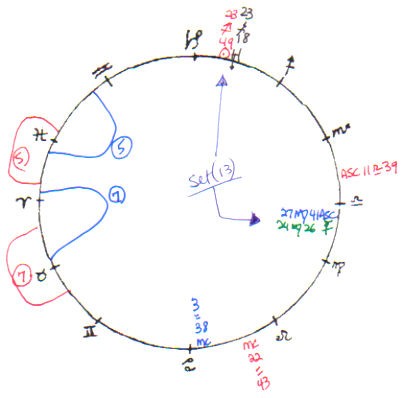
Set (13) shows B Asc/mercury/sun/uranus. That is, mercury is Angular, and it is in the same set with c7 uranus, ruler of c 5th house.
His personal life was unhappy and disorganized. Verlaine's marriage to Mathilde Maute de Fleuville in 1870 was strained by his bohemian habits and homosexual relationship with Rimbaud. It ended in a legal separation in 1872 and divorce in 1885. One source of unhappiness for him was his lover, Rimbaud, whom he shot after a quarrel in 1873. Verlaine was imprisoned for two years for his crime.
His indulgences in alcohol and debauchery helped lead to his death on 1/08/1896, Paris, France.
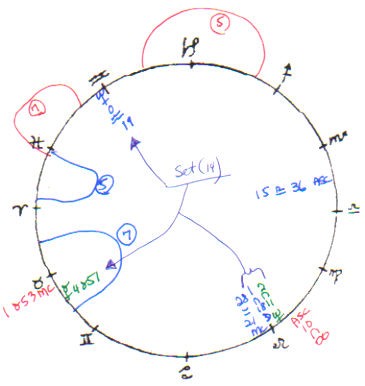
Set (14) includes C MC/moon/mercury/2neptune. The conjunction of C MC with mercury is in b 7th house. B neptune rules b 5th house. Even though the orb from C MC to mercury is within our 4°, the moon in the set increases orb and the set more acceptable.

Gore Vidal was born at the military academy in West Point, New York, where his father was an instructor. He grew up near Washington, D.C., in his grandfather’s house. As a teenager, Vidal adopted the first name of Gore. Vidal learned about political and social life among notables. He also spent time on the Virginia estate of his stepfather, Hugh D. Auchincloss.
After graduating from Philips Exeter Academy in New Hampshire, he served in the Army. When he was discharged, he worked for six months for the publishing firm of E. P. Dutton. From 1947 to 1949 he lived in Antigua, Guatemala. A basically self-taught writer (he has no college degree), his first novel, "Williwaw," was based on his youthful wartime experiences.
In his autobiography, Vidal admitted to being a selfish lover because he likes to receive pleasure rather than give it. So he concluded long ago that sex is an urge, that love is an impossibility, and that you should never have sex with someone you might actually like, which led him to literally thousands of anonymous trysts throughout the years.
The sole exception was Jim Trimble, his boyhood friend and lover, who died at Iwo Jima in 1945, and whose death Vidal never forgot. Perhaps his most startling and intimate confession was that his relationship with Howard Austen was never sexual, though they lived together for 44 years.
"The City and The Pillar," 1948 shocked the public with its homosexual main character. He became known as a serious writer by the age of 21. After several of his novels did not receive acclaim, he began writing plays for television, motion pictures and stage. Among the best known of these works from the 1950s is "Visit to a Small Planet," first produced for television in 1955.
"Myra Breckenridge," 1968 was a transsexual comedy parodying the cult of a Hollywood film star. "Myron," 1974, its sequel, is about the alternate self of Myra.
As an essayist, Vidal has dealt with a variety of topics. His family and social contacts have provided him with a wealth of material, including his grandparents and his relation to Jackie Kennedy through his mother’s marriage to Hugh Auchincloss (who was also married to Jackie’s mother at one time). He has often been pointedly controversial, as when he supported legalization of street drugs.
In politics, Vidal’s leanings are liberal. In 1960 he ran unsuccessfully for Congress in New York. Between 1970 and 1972 he was co-chairman of the People’s Party. In 1982 he ran for U.S. Senate from California and came in second of nine candidates.
In 1998, he published "The Smithsonian Institution." His series of historical novels that make up a biography of the nation, including "Washington, D.C.," will be complete with the seventh, "The Golden Age."
On 03/22/1999 he was hospitalized in Italy for rectal hemorrhage. Glaucoma has slowed Vidal down somewhat in the ‘90s. He and male companion of more than 30 years, Howard Austin, split their time between the U.S. and a villa on the Amalfi coast in Italy.
Wikipedia for 1/17/11, under the heading “Personal Life,” states that

Set (15) occurs in all charts because there are no harmonics in it. It includes C MC/sun/2mercury/jupiter/pluto. B mercury rules b 8th house. This is the set that also shows his enormous writing talents. With sun and mercury in Virgo, he is likely to be good at criticism and analysis. B sun’s rulership of B MC in c 3rd house makes sure that the set also influences a 3rd house (in addition to the two Angular mercuries).
Vidal has an Angular golden benefic in his 7th chart. B moon at 4 Aries 24, C Asc at 2 Cancer 49, b7 venus at 3 Libra 09, and c7 jupiter at 4 Libra 37 comprise the set. The conjunction of venus to jupiter in Libra promises luck (jupiter) in love (venus).
Vidal shows a powerful sexuality in this chart. B Asc in Scorpio is conjunct b5 moon, b5 venus, and b5 mars, all in Scorpio, and in the same set with b5 neptune in Aquarius. In the first paper on bisexuality, Angle/light/venus + mars/neptune/5th is seen as an ever-hungry sexuality. In that set, b5 mars in Scorpio rules B Asc in c 5th house and rules b 5th house, so the set influences both 5th houses and two Angles, also making it powerful.
His 12th chart shows B Asc in the same set with moon/venus/saturn/neptune, with influence to both 5th houses, the likely set that shows the pain he experienced on the death, in 1945, of his boyhood friend and lover, Jim Trimble.
He met Evelyn Gardner in April 1927 and they married on 6/27/1928. Two years later his wife fell in love with another man and filed for divorce. His interest in Catholicism began at about this time. Through 1932, he had a difficult period with women and continued to have unsatisfactory affairs. In December 1934, he fell in love with Laura Herbert. He proposed in August 1936 and they married on 4/17/1937. He had a total of seven kids, losing one daughter at birth. His father died on 6/24/1943 and his mother in 1954.
Waugh became a convert to Roman Catholicism, being received into the church on 9/29/1930. Some years later, when upon questioning his belief system toward the end of 1954, he became deeply despondent. At the end of 1953 his health was deteriorating and he suffered from delusions. He hoped for a cure from a cruise in January 1954 but he became so deranged that the captain put him ashore at Port Said. He flew to Ceylon where his wife joined him to take him back to England with a complete mental breakdown.
Excerpted from Wikipedia on 1/17/11, we have: The arrival in Oxford in October 1922 of the sophisticated Etonians Harold Acton and Brian Howard changed Waugh's Oxford life. Acton and Howard rapidly became the centre of an avant-garde circle known as the Hypocrites, whose artistic, social and homosexual values Waugh adopted enthusiastically;later wrote: "It was the stamping ground of half my Oxford life". He began drinking heavily, and embarked on the first of several homosexual relationships, the most lasting of which were with Richard Pares and Alastair Graham. He continued to write reviews and short stories for the university journals, and developed a reputation as a talented graphic artist, but formal study largely ceased. This neglect led to a bitter feud between Waugh and his history tutor, dean (and later principal) of Hertford College. When Cruttwell advised him to mend his ways, Waugh responded in a manner he admitted later was "fatuously haughty", from which point relations between the two descended into mutual hatred. Waugh continued the feud long after his Oxford days, by using Cruttwell's name in his early novels for a succession of ludicrous, ignominious or odious minor characters.
…Having given up teaching, he had no regular employment except for a short, unsuccessful stint as a reporter on the Daily Express in April–May 1927. That year, his homosexual phase now in the past, he met (possibly through brother Alec) and fell in love with Evelyn Gardner, the daughter of Lord and Lady Burghclere.
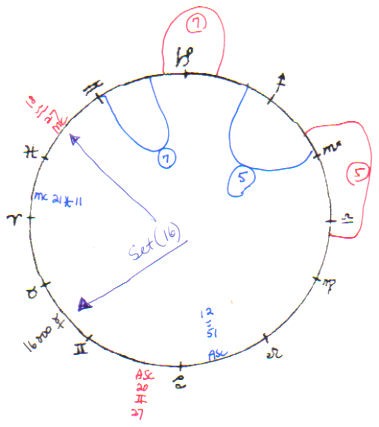
Set (16) shows C MC in the same set with c5 mercury, ruler of C Asc and c 5th house.

After receiving only an elementary education, he began omnivorous reading and worked as a printer, journalist and schoolteacher 1832-1845. He became an editor for the Brooklyn Eagle in 1846, but his views supporting abolitionism and free soil resulted in his termination. Offered a job on a newspaper in New Orleans, his two week train trip allowed him to see a large amount of the country, broadening his horizons for his poetry. His first edition of "Leaves Of Grass" was a collection of twelve poems and was hailed by Emerson. Later editions of "Leaves" were revised and enlarged, becoming best sellers in spite of unfavorable regard by critics.
In 1862, he moved to Virginia during the Civil War to care for a brother injured in service. The horrors he saw led to his volunteer work in the hospitals of Washington, D.C., staying for 11 years with jobs as the army paymaster and Dept. of the Interior. A stroke in 1873 left him with paralysis, forced him to leave his job and the capitol to live with his brother George in Camden, NJ. Although he grew feeble, he continued to write brief poems, received many visitors from across the country and foreign lands and before his death, he wrote "A Backward Glance O'er Travel'd Roads."
Whitman claimed to have fathered six illegitimate kids on his travels and he died on 3/26/1892, Camden, NJ.
From Wikipedia (1/17/11) we have the following statements: Whitman's sexuality is often discussed alongside his poetry. Though biographers continue to debate his sexuality, he is usually described as either homosexual or bisexual in his feelings and attractions. However, there is disagreement among biographers as to whether Whitman had actual sexual experiences with men.
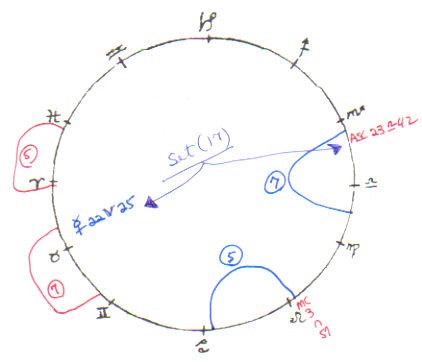
Set (17), which occurs in all his charts because it has no harmonics, shows b mercury conjunct conception Descendant. B mercury also rules b 7th house, so both 7th houses are under its influence.
Whitman’s poetry, mysticism, and homosexual leanings show in his 3rd chart, making that his likely center of gravity (COG) chart. The 3rd chart or a strong 3rd house/Gemini is also suggested by “he began omnivorous reading and worked as a printer, journalist, and schoolteacher 1832-1845 (from bio above).” All these pursuits are mercurial. Let’s take at those sets in his 3rd chart.
Here is the set that shows his homosexuality:
| Set (17a) | c3 saturn | 29 Taurus 18 | co-ruler (30 36°) c 3rd house |
| c mercury | 3 Virgo 16 | ruler of c 9th house | |
| c3 sun | 3 Virgo 34 | ruler of C MC | |
| b3 moon | 3 Virgo 54 | ruler of b 5th house | |
| c mars | 4 Virgo 18 | ruler of c 7th house | |
| b uranus | 0 Sagittarius 53 | ||
| c neptune | 1 Sagittarius 34 | ruler of c 5th house | |
| b3 mars | 3 Sagittarius 58 | ||
| b neptune | 5 Sagittarius 36 | ruler of B Asc in c 5th house | |
| c pluto | 3 Pisces 43 | ||
| b pluto | 5 Pisces 15 | ||
| b saturn | 7 Pisces 03 |
Set (17a) also has a wide spread—almost 8°, but it also has two lights in its approximately center, so it is a valid set.
Set (17a) includes all the first part of the significator for homosexuality--Angle/light/mars/neptune/5th/(7th). It is very strong because it influences two Angles and both 5th houses. The saturns in it would not prevent homosexual feelings. We know that because many of the charts of practicing homosexuals also have saturn in this part of their significator.
Whitman does not have the second part of the significator for homosexuality, which is Angle/mars/7th?(5th?). But, he doesn’t need it in order to express his homosexuality because he has the significator, shown above in the drawing as Set (17), the bisexual significator. That gives him a choice of homosexual or heterosexual partnerships.
The significators for a known poet are Angle/light/mercury/venus/3rd. It usually occurs in the 7th or 10th charts, but can occur in others, particularly the 3rd chart. There is often also a light in Pisces. For poetry Whitman has:
| Set (17b) | b3 mercury | 22 Pisces 06 | co-ruler (12 of 22°) of b 3rd house |
| c3 venus | 25 Pisces 28 | ruler of C Asc | |
| b NN | 26 Pisces 46 |
He doesn’t have a light in Pisces in this chart, but that mercury in Pisces comes in a close second, especially since it co-rules the 3rd house, where, because of its tendency to mitigate against discrete, linear thinking, it also sponsors some psychic abilities.
Two sets suggest the subject of his poetry:
| Set (17c) | b3 uranus | 4 Aries 25 | |
| c3 moon | 7 Aries 20 | co-ruler (30 of 36°) of c 9th house | |
| c3 neptune | 7 Aries 52 | ruler of c 5th house | |
| c NN | 9 Aries 37 | ||
| b venus | 12 Aries 46 | ruler of c 3rd house | |
| b3 jupiter | 4 Capricorn 38 | ruler of B MC |
Set (17c) holds together even though it has a large spread—8° 21’ from b3 uranus to b venus—because it has two lights more or less in the center of the set. It is forefront because it contains a light and influences an Angle. It suggests some one unusually (Aries) ardent (Aries) and sensitive (venus/uranus/neptune) to beauty (venus) who will experience spiritual overtones (9th influence) in it. He is rewarded for such perceptions by spiritual growth (NN) and joy (the set contains a golden benefic).
A second set shows an even stronger mystical bent:
| Set (17d) | b mercury | 22 Aries 25 | ruler of b 4th, co-ruler (12 of 22°) of b 3rd houses |
| c moon | 25 Aries 28 | co-ruler (30 of 36°) b 9th house | |
| b3 neptune | 27 Aries 59 | ruler of B Asc in c 5th house | |
| b jupiter | 24 Capricorn 56 | ruler of B MC |
Set (17d) contains Angle/light/jupiter/neptune, a mystical set, or, stated more concretely, a set which inspires (jupiter and neptune) the individual to expansion and growth (jupiter) through reaching beyond the known (neptune). The set is forefront because it contains a light and influences an Angle. Set (17d) also influence houses 4, 5, 9—the same houses usually present in sets of gurus demonstrating their achievement, usually (but definitely not always) accompanied by sublimation of sexuality (5th) for spiritual purposes (9th).
Set (17d) is not, however, the only set which suggests Whitman sublimated at least some part of his sexuality. He has C MC at 3 Leo 57 conjunct b3 saturn at 5 Leo 13 conjunct c sun at 6 Leo 43 and conjunct b moon at 6 Leo 47. All these are opposite b3 venus at 3 Aquarius 52, ruler of b 3rd, co-ruler (25 of 40°) b 7th house, B moon rules b 5th house. C sun rules the Angle it is conjunct. Leo is the sign naturally associated with the 5th house of sexuality and children, and stands for pride, dignity, flamboyance, all-out being, drama. Saturn conjunct the Leo planets suggests their suppression. Venus/saturn suggests emotional pain, which could be just enough to make him search for ways other than homosexuality to express his sexuality, that is, through his writing..
So, based only on his astrology, I tend to doubt Whitman had all those (six?!) illegitimate children. First, it would have been extraordinarily insensitive of him to be such a sexual Johnny Appleseed in a time when women were not allowed to support themselves. Second, living at the time he did, having written the often overtly homosexual material he did, he probably needed to create some counter-image to keep social peace. Who would have believed any explanation he had to give, anyway?
Whitman’s 3rd chart was undoubtedly his COG chart, but he has a strong set in his 6th chart worth mentioning. To his B MC at 11 Sagittarius 37 conjunct his c jupiter at 11 Sagittarius 03, his 6th chart adds b6 venus at 12 Sagittarius 11 and b6 sun at 13 Virgo 42, giving him a powerful golden benefic in this chart. His biographical material (above) states he “moved to Virginia to care fro a brother injured in service. The horrors he saw led to his volunteer work in the hospitals of Washington, D.C., staying for 11 years…”

Wilde's true genius emerged through his talk and journalism, after leaving Oxford, in 1878. Journalism was always Wilde's first love, so strong that he spent two years editing a women's magazine called "The Lady's World." Wilde, after taking over the magazine, renamed it "The Woman's World," and helped to create the everlasting women's magazine formula of campy frivolity and feminist earnestness. With such a lofty position at this stage in life, it was inevitable that Wilde would eventually have to make his way into society, which he did through radiant humor and top-this wit. In December 1881, without even a lecture written, Wilde set out on an American lecture tour that brought nothing but success to him; his combination of wit and easy material made it very easy for Wilde. Following his American success, Wilde made a lengthy stay in Paris, which, unfortunately, did not bring him as much success as in America. He soon discovered that wit and easy material do not go nearly as far to impress Parisians already so culturally in the know. In 1883, he returned to England. One of his earliest works, "The Picture of Dorian Gray" revolved around this coming-home time period in Wilde's life. Comedy and wit became part of his life, once again, through four well written comedies beginning in 1891: "Lady Windermere's Fan," "A Woman of No Importance," "An Ideal Husband" and, above all, "The Importance of Being Earnest."
Wilde married his wife, Constance Lloyd, in 1884. Their marriage appeared to be a perfect love match, that is, until after the couple had children. After childbearing, he revealed to Frank Harris that he was revolted by his wife's body, "When I married, my wife was a beautiful girl, white and slim as a lily....In a year or so all the flowerlike grace had vanished; she became heavy, shapeless, deformed." It may have been this less-than-ideal view of his wife that caused Wilde, by the end of 1887, to become involved in his first extended "same sex" romance with a man named Robbie Ross. Four years later, in 1891, he met Lord Alfred (Bosie) Douglas, a gorgeous homosexual son of the Marquis of Queensbury. It was at this time that they began their doomed affair, the affair that would eventually lead to Wilde spending two years of his life in jail.
On 10/29/1900, he was bankrupt and practically bedridden in a Paris hotel room, He had surgery several weeks before for an ear infection and for the first time since the surgery, summoned enough strength to walk to a cafe for a glass of absinthe. He remarked that "My wallpaper and I are fighting a duel to the death. One or the other of us has to go." The next day he complained of severe pain in his ear. An abscess developed which led to acute meningitis, related some say, to syphilis. He suffered for weeks, getting little relief from opium, morphine and champagne. During his final semiconscious moments, his companions saw that he was received into the Catholic Church.
He died of encephalitis on 11/30/1900, Paris, France.
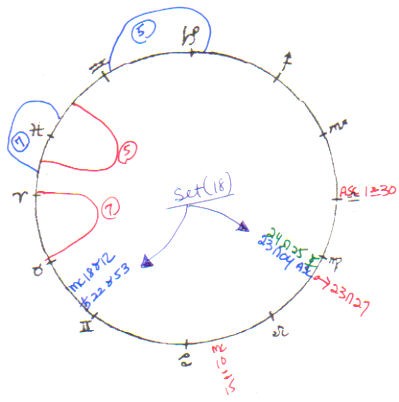
Set (18) shows B Asc in the same set with mercury/mars/saturn. C mars rules c 7th house. B saturn rules b 5th house, an afflicted but bisexual set.
Discussion
My only aim in this paper was to show more people—in addition to those in the first paper—with a reputation for bisexuality also have an astrology symbolizing it. Combined with bisexual individuals in the first paper, the total count is 33, with one more (Flaubert), not having the significator though he himself claimed bisexuality. Several who have only the barest suggestion of being bisexual do have the significator, for instance, Monroe in the earlier paper, and de Beauvoir in this one.
